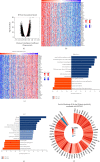HtrA2 Independently Predicts Poor Prognosis and Correlates with Immune Cell Infiltration in Hepatocellular Carcinoma
- PMID: 36704205
- PMCID: PMC9873461
- DOI: 10.1155/2023/4067418
HtrA2 Independently Predicts Poor Prognosis and Correlates with Immune Cell Infiltration in Hepatocellular Carcinoma
Abstract
High-temperature requirement protein A2 (HtrA2), a mitochondrial protein, is related to apoptosis regulation. However, the role of HtrA2 in hepatocellular carcinoma (HCC) remains unclear. In the present study, we explored the prognostic value and expression pattern of HtrA2 in HCC and confirmed its independent value for predicting outcomes via Cox analyses. LinkedOmics and GEPIA2 were used to construct the coexpression and functional networks of HtrA2. Additionally, the data obtained from TCGA was analyzed to investigate the relationship between the infiltration of immune cells and HtrA2 mRNA expression. Finally, the expression pattern of HtrA2 in HCC was confirmed by wet-lab experiments. The results showed high HtrA2 expression (P < 0.001) presented in tumor tissues in TCGA-HCC. Moreover, high HtrA2 expression was confirmed to be associated with poor HCC patient survival (P < 0.05). HtrA2 has also been recognized as an essential risk factor for overall survival (P=0.01, HR = 1.654, 95% CI 1.128-2.425), disease-specific survival (P=0.004, HR = 2.204, 95% CI 1.294-3.753), and progression-free interval (P=0.007, HR = 1.637, 95% CI 1.145-2.341) of HCC. HCC patients with low HtrA2 methylation had worse overall survival than patients with high methylation (P=0.0019). Functional network analysis suggests that HtrA2 regulates mitochondrial homeostasis through pathways involving multiple microRNAs and transcription factors in HCC. In addition, HtrA2 expression correlated with infiltrating levels of multiple immune cell populations. At last, increased expression of HtrA2 in HCC was confirmed using wet-lab experiments. Our study provides evidence that the upregulation of HtrA2 in HCC is an independent predictor of prognosis. Our results provide the foundation for further study on the roles of HtrA2 in HCC tumorigenesis.
Copyright © 2023 Lei Feng et al.
Conflict of interest statement
The authors declare that there are no conflicts of interest.
Figures








References
LinkOut - more resources
Full Text Sources
Miscellaneous

